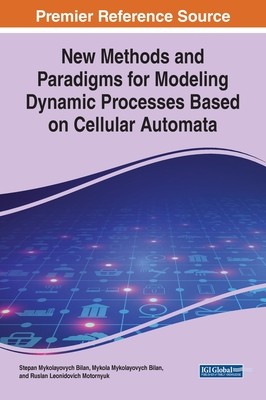
- We will send in 10–14 business days.
- Author: Stepan Mykolayovych Bilan
- Publisher: Engineering Science Reference
- Year: 2020
- Pages: 344
- ISBN-10: 179982649X
- ISBN-13: 9781799826491
- Format: 17.8 x 25.4 x 2.1 cm, hardcover
- Language: English
- SAVE -10% with code: EXTRA
New Methods and Paradigms for Modeling Dynamic Processes Based on Cellular Automata (e-book) (used book) | bookbook.eu
Reviews
Description
The accelerating development of computer technology and communications can replace many of the functions of human intellectual activity, as well as help them in making decisions in various situations of their lives. To implement intelligent functions for various purposes, numerous models, paradigms, architectures, and hardware and software are being developed. Because the world is constantly evolving, there is a need to constantly study various dynamic processes to determine possible negative situations that can lead to undesirable catastrophic phenomena and changes. Recently, more attention has been paid to the study of natural processes in nature. Scientific works are appearing that describe the behavior and development of living organisms and the processes of their interaction. Cellular automata are increasingly used to describe and model them. New Methods and Paradigms for Modeling Dynamic Processes Based on Cellular Automata is a collection of innovative research that describes the models and paradigms of building cellular automata that allows for the simulation of the dynamics of the interaction of living organisms from a different scientific point of view. For this, asynchronous cellular automata with a dynamically changing number of "living" cells are used. The chapters describe the theoretical concepts of constructing asynchronous cellular automata with active cells. Much attention is paid to the use of the proposed theoretical principles for solving modeling problems and solving specific applied problems of forming pseudorandom sequences and image processing based on modeling of the human visual channel. Featuring research on topics such as colony interaction, image processing and recognition, and influence mode, this book is ideally designed for engineers, programmers, software developers, researchers, academicians, and students.
EXTRA 10 % discount with code: EXTRA
The promotion ends in 20d.17:04:27
The discount code is valid when purchasing from 10 €. Discounts do not stack.
- Author: Stepan Mykolayovych Bilan
- Publisher: Engineering Science Reference
- Year: 2020
- Pages: 344
- ISBN-10: 179982649X
- ISBN-13: 9781799826491
- Format: 17.8 x 25.4 x 2.1 cm, hardcover
- Language: English English
The accelerating development of computer technology and communications can replace many of the functions of human intellectual activity, as well as help them in making decisions in various situations of their lives. To implement intelligent functions for various purposes, numerous models, paradigms, architectures, and hardware and software are being developed. Because the world is constantly evolving, there is a need to constantly study various dynamic processes to determine possible negative situations that can lead to undesirable catastrophic phenomena and changes. Recently, more attention has been paid to the study of natural processes in nature. Scientific works are appearing that describe the behavior and development of living organisms and the processes of their interaction. Cellular automata are increasingly used to describe and model them. New Methods and Paradigms for Modeling Dynamic Processes Based on Cellular Automata is a collection of innovative research that describes the models and paradigms of building cellular automata that allows for the simulation of the dynamics of the interaction of living organisms from a different scientific point of view. For this, asynchronous cellular automata with a dynamically changing number of "living" cells are used. The chapters describe the theoretical concepts of constructing asynchronous cellular automata with active cells. Much attention is paid to the use of the proposed theoretical principles for solving modeling problems and solving specific applied problems of forming pseudorandom sequences and image processing based on modeling of the human visual channel. Featuring research on topics such as colony interaction, image processing and recognition, and influence mode, this book is ideally designed for engineers, programmers, software developers, researchers, academicians, and students.


Reviews